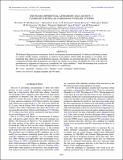| dc.contributor.author | Muterspaugh, Matthew W. | |
| dc.contributor.author | Lane, Benjamin F. | |
| dc.contributor.author | Kulkarni, S. R. | |
| dc.contributor.author | Konacki, Maciej | |
| dc.contributor.author | Burke, Bernard F. | |
| dc.contributor.author | Colavita, M. M. | |
| dc.contributor.author | Shao, M. | |
| dc.contributor.author | Hartkopf, William I. | |
| dc.contributor.author | Boss, Alan P. | |
| dc.contributor.author | Williamson, M. | |
| dc.date.accessioned | 2015-01-30T20:32:20Z | |
| dc.date.available | 2015-01-30T20:32:20Z | |
| dc.date.issued | 2010-12 | |
| dc.date.submitted | 2010-07 | |
| dc.identifier.issn | 0004-6256 | |
| dc.identifier.issn | 1538-3881 | |
| dc.identifier.uri | http://hdl.handle.net/1721.1/93249 | |
| dc.description.abstract | The Palomar High-precision Astrometric Search for Exoplanet Systems monitored 51 subarcsecond binary systems to evaluate whether tertiary companions as small as Jovian planets orbited either the primary or secondary stars, perturbing their otherwise smooth Keplerian motions. Six binaries are presented that show evidence of substellar companions orbiting either the primary or secondary star. Of these six systems, the likelihoods of two of the detected perturbations to represent real objects are considered to be "high confidence," while the remaining four systems are less certain and will require continued observations for confirmation. | en_US |
| dc.description.sponsorship | National Science Foundation (U.S.) (grant AST 0300096) | en_US |
| dc.description.sponsorship | National Science Foundation (U.S.) (grant AST 0507590) | en_US |
| dc.description.sponsorship | National Science Foundation (U.S.) (grant AST 0505366) | en_US |
| dc.description.sponsorship | Foundation for Polish Science (FOCUS grant and fellowship) | en_US |
| dc.description.sponsorship | Poland. Ministry of Science and Higher Education (grant N203 3020 35) | en_US |
| dc.language.iso | en_US | |
| dc.publisher | Institute of Physics/American Astronomical Society | en_US |
| dc.relation.isversionof | http://dx.doi.org/10.1088/0004-6256/140/6/1657 | en_US |
| dc.rights | Article is made available in accordance with the publisher's policy and may be subject to US copyright law. Please refer to the publisher's site for terms of use. | en_US |
| dc.source | American Astronomical Society | en_US |
| dc.title | THE PHASES DIFFERENTIAL ASTROMETRY DATA ARCHIVE. V. CANDIDATE SUBSTELLAR COMPANIONS TO BINARY SYSTEMS | en_US |
| dc.type | Article | en_US |
| dc.identifier.citation | Muterspaugh, Matthew W., Benjamin F. Lane, S. R. Kulkarni, Maciej Konacki, Bernard F. Burke, M. M. Colavita, M. Shao, William I. Hartkopf, Alan P. Boss, and M. Williamson. “THE PHASES DIFFERENTIAL ASTROMETRY DATA ARCHIVE. V. CANDIDATE SUBSTELLAR COMPANIONS TO BINARY SYSTEMS.” The Astronomical Journal 140, no. 6 (October 20, 2010): 1657–1671. © 2010 American Astronomical Society. | en_US |
| dc.contributor.department | Massachusetts Institute of Technology. Department of Physics | en_US |
| dc.contributor.department | MIT Kavli Institute for Astrophysics and Space Research | en_US |
| dc.contributor.mitauthor | Burke, Bernard F. | en_US |
| dc.relation.journal | Astronomical Journal | en_US |
| dc.eprint.version | Final published version | en_US |
| dc.type.uri | http://purl.org/eprint/type/JournalArticle | en_US |
| eprint.status | http://purl.org/eprint/status/PeerReviewed | en_US |
| dspace.orderedauthors | Muterspaugh, Matthew W.; Lane, Benjamin F.; Kulkarni, S. R.; Konacki, Maciej; Burke, Bernard F.; Colavita, M. M.; Shao, M.; Hartkopf, William I.; Boss, Alan P.; Williamson, M. | en_US |
| dc.identifier.orcid | https://orcid.org/0000-0002-3182-3304 | |
| mit.license | PUBLISHER_POLICY | en_US |
| mit.metadata.status | Complete | |
